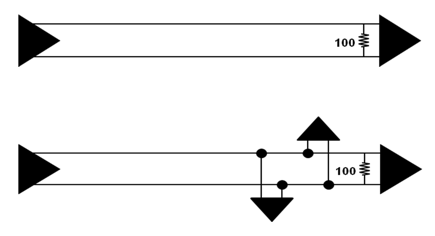-
Can LVDS be used to drive multiple loads (multi-drop) ?LVDS is primarily a point-to-point signaling technology meaning 1 driver and 1 receiver. In some special circumstances LVDS can be used to drive multiple loads; in this case the driver must be at one end of the transmission line and the 100 ohm termination at the other. It is essential the loads have very short stubs. (see figure).

Point-to-point (top) and Multidrop (bottom)
A better solution is to use M-LVDS when multi-drop or multi-point architectures are required. M-LVDS is optimized for multi-drop applications and has slow controlled edge rates to minimize reflections due to impedance discontinuities such as stubs. In typical multi-drop or multi-point configurations, such as backplanes, terminations are placed at each end resulting in an effective RL/2 impedance. M-LVDS has significantly greater drive and thus able to drive this heavier load.
Back to Top
Typical Multi-drop configuration suitable for M-LVDS
-
When should signals be AC coupled ?Adding capacitors to both sides of the differential pair is known as AC coupling and is used to isolate the driver and receiver. Some high performance receivers have a limited common mode and the AC coupled termination can be used to set the input common mode at the receiver sweet spot. Communication standards such as PCIe require AC coupling and this approach assists with compatibility between vendors. An essential requirement with AC coupled signals is the need for DC balance, such as 8b/10b coding.
In physically distributed or noisy systems AC coupling may be used to avoid problems due to large common mode variations between the differential driver and receiver. Telefunken extended common mode LVDS alleviates much of this problem by offering a very wide -7 to +12V common mode.
Back to Top
AC coupled termination
-
How do I translate CML and/or LVPECL to LVDS ?LVDS inputs are able to accept signal swings from 100mV to 1V and over a wide common mode. For this reason LVDS acts as a universal translator able to interface directly with almost all high-speed differential technologies.
Back to Top -
In what circumstances can LVDS replace RS-485 ?RS-485/422 is a robust solution for long distance, low data-rate applications. Drawbacks to RS-485 are poor bandwidth, high power per bit and EMI, making LVDS an attractive replacement where appropriate. In general, LVDS is suitable for distances up to 50m and the extended common mode devices available from Telefunken greatly increase the noise margin. Replacing an entire RS-485 network with LVDS or M-LVDS is the preferred solution although with special termination schemes a mixed network is possible. Contact the Telefunken applications group for specific information on mixed network operation.
Back to Top
